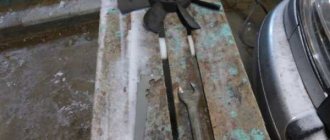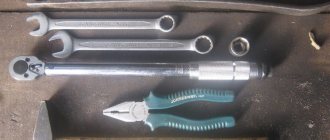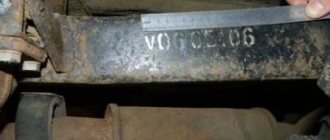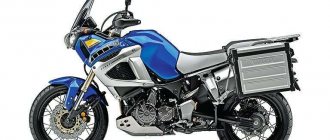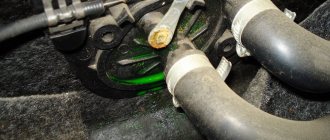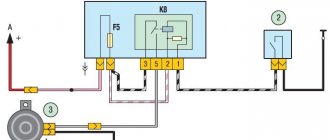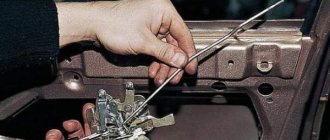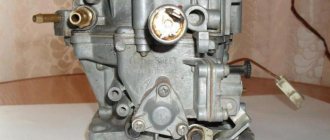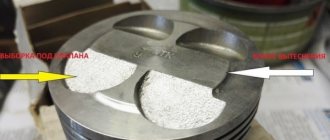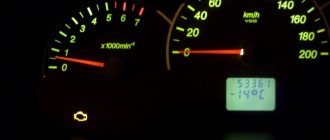Driving a car used to be quite a difficult task. The power steering, also known as power steering, of the Lada Priora makes the steering wheel of the car light. The electric booster is even lighter, but not more informative. Priora has configurations with EUR and power steering. The amplifier operates using liquid, so in comparison with an electric amplifier, you need to monitor the level. On Priora, the assembled part will cost more than 7 thousand. The price is for the kit - it consists of 11 parts. Constantly being on the road tires you not only with emotional fatigue, but also with the incessant movement of the steering wheel, gear lever and pressing the pedals. To reduce the load on muscles, various systems are built into cars. Some of them make the pedals “lighter”, while others make it easier to turn the steering wheel.
The power steering for the Priora car has become a real salvation; the steering wheel has become lighter and more comfortable to use: to make a turn, you don’t need to use too much effort, tiring yourself. The power steering immediately picks up the force that the driver applies to the steering wheel and begins its work.
However, the mechanism requires attention: at certain moments it is necessary not to forget about replacing the Priora power steering fluid. Also, after a couple of years the hose cracks, so replacing the power steering hose in a Priora car is a matter of 3-6 years.
Standard power steering (hydraulic booster) - article number and price
The standard power steering for the Priora received catalog number 21230340701200, the cost is from 7,500 rubles. Before ordering and purchasing, you should check the availability of fasteners. But the system itself is sold for spare parts:
- Long oil tank strap - 21100341010500 - about 500 rubles.
- Oil tank bracket - 21100341010000 - about 150 rubles.
- Power steering tank - 21230341001000 - about 900 rubles.
- Supply pipe - 21100340812500 - about 1,000 rubles.
- Power steering pump - 21100340700900 - about 6,000 rubles.
- Pillow – 21100340804000 – about 400 rubles.
- Low pressure pipe – 21100340804000 – about 400 rub.
- High pressure hose with tube – 2110034801810 – about 1,900 RUR.
- High pressure pipe – 21100340808001 – about 900 rub.
- Low pressure hose with tube – 21100340802600 – about 1,800 RUR.
- Front high pressure hose – 21100340810010 – about 1600 rub.
Replacing power steering hoses
Simultaneously with replacing the pump or power steering fluid, it is recommended to thoroughly check the condition of the hoses and pipes. If necessary, replace them with new ones. Hoses must be changed only after the oil has been completely pumped out.
To replace hoses or pipes, first unscrew the clamps. Installing new hoses causes some inconvenience, since the location of the hydraulic booster is not entirely convenient for performing such operations. New hoses and pipes should be securely secured with clamps. However, you should not be too zealous so as not to damage them.
What does the power steering system consist of and how does it work?
The Priora's power steering works in the steering system. Its main part is the pump. The system fluid circulates in a special tank, pipes, and hoses that can withstand high pressure.
The operation of the hydraulic booster depends on the quality and “purity” of the corresponding working fluid in the system. When the driver turns the steering wheel, the pump increases the pressure of the working fluid, and it pushes the piston, increasing the force on the steering rack. In this case, the force that develops thanks to the pump is proportional to the resistance force that acts on the wheels - be it off-road or on a free track.
It turns out that at high speed the Priora’s hydraulic booster practically does not work - changing lanes or turning requires the least effort. A special torsion bar device, which is part of the steering mechanism, helps to properly distribute the resulting forces. Having received a signal in time that the created pressure is sufficient, the pump stops its operation, and sufficient auxiliary force is created to turn the steering wheel. It turns out that while driving, the driver constantly needs to act on the steering wheel with the same force, because the power steering always minimizes the impact of the opposing force.
The design and principle of operation of the Priora steering mechanism
On front-wheel drive vehicles, due to their design features, it is impossible to install a classic steering mechanism. The first thing engineers encounter is lack of space. A standard mechanism cannot be installed, even if a transverse engine is used instead of an in-line engine. For this reason, the classics, which are not distinguished by modest dimensions, have been replaced by a compact steering rack, which transmits the force when turning the steering wheel to the front wheels.
To save as much space as possible, on Priora and many other cars the rack is rigidly fixed to the front panel of the engine compartment - between the engine and the passenger compartment. It connects to the steering column, which extends into the cabin and ends with the steering wheel. The steering rack is a toothed metal rod. Its teeth engage with the steering wheel drive in the form of a shaft. They are located relative to each other at right angles. This is an improved worm drive.
The driver rotates the steering wheel along with a shaft, the teeth of which move the steering rack inside the casing, engaging with a toothed rod. There are holes in the rack casing through which the steering ends (rods) are connected. In the center of the rack itself there are holes for attaching these tips, which are attached to the steering knuckles of the front wheel strut using rods and special levers.
Main faults of the hydraulic booster on a Lada Priora car
When operating a Priora with power steering, the following problems may occur:
- When turning the steering wheel, a feedback is felt, similar to a push in the opposite direction (replacing or tightening the drive belt will help);
- It is difficult to turn the steering wheel (replacing or tightening the belt will help; adding fluid to the tank to the normal level, replacing or cleaning the filter; replacing the pump; removing the air lock or adjusting the idle speed);
- The steering is too “smooth” (adding fluid, removing the air lock and checking the steering, changing the tires will help);
- Extraneous noise during operation of the power steering (adding fluid, removing air lock or mechanical damage, checking the pump and replacing it will help);
- The steering wheel vibrates with weak shocks (removing the air lock in the system, balancing the wheels or changing the tires will help).
Problems in the operation of the hydraulic booster
All breakdowns of the Priora power steering, as well as the causes and methods of eliminating them, are listed in the table:
| Malfunction | Cause | Remedy |
| When turning the steering wheel, you feel a kickback (shocks in the opposite direction) | Worn or loose pump drive belt | Replacing or adjusting belt tension |
| It takes a lot of effort to turn the steering wheel. | The pump belt is worn or loose. Low fluid level in the reservoir. The fluid reservoir filter is clogged. Low pump pressure or air lock in the system. Insufficient engine idle speed. | Adjust or replace the drive belt. Add liquid to the reservoir. Replace or clean the filter. Replace the pump. Remove the air lock. Adjust idle speed. |
| More effort is required to rotate the steering wheel in the middle position | Pump or steering mechanism faulty | Check, repair or replace the pump. Find and fix the steering mechanism problem |
| More effort is required to turn the steering wheel to one side | The pump has failed | Pump repair or replacement |
| Steering is unclear | There is not enough fluid in the reservoir or it is leaking. Air in the power steering system. Resource development. | Add fluid and fix leaks if any. Remove the air lock. Check steering components and replace if necessary. Replace tires. |
| It takes a lot of physical effort to quickly turn the steering wheel | The belt tension has weakened. Air in the system. The pump is faulty. Failure of parts of the steering mechanism. Floating idle speed. | Pull the belt. Remove the air lock. Replace the pump if it cannot be repaired. Check and eliminate faulty parts of the steering mechanism. Adjust idle speed. |
| Noise during power steering operation | There is not enough liquid in the tank. The liquid is discharged through the safety valve (a whistle is heard when the steering wheel is turned to the extreme position). | Add fluid and fix the leak. Remove the air lock. Check the pump pressure, repair or replace the part. |
| Steering wheel vibration | Airlock. The wheels are out of balance or the tires are damaged. | Remove air. Balance wheels or replace tires |
In practical terms, power steering is more often replaced with a new one or with a known good one. The original device costs a lot, so they choose analogues. Models from Chinese manufacturers have proven themselves to be an inexpensive option of good quality.
Repair: removal and installation of power steering Lada Priora
Replacement of Gur Priora and its repair must begin with correct diagnosis. It is also worth inspecting the reservoir of pipes and hoses in order to notice any damage in time. To remove the power steering you will need:
- stopper for retaining rings;
- key 12, head 14, 24;
- new bearing;
- syringe and container for draining liquid;
- fine-grained sandpaper and clean rags.
Working with power steering requires care - the system must remain sealed. The low pressure hose (2110 3408026 – article number) is often damaged. Therefore, the reason for the intrusion into the power steering system is the replacement of the Priora power steering hose. Repair work is carried out as follows:
- Park the car on level ground, tighten the handbrake, remove the negative from the battery.
- Find the hole in the pulley and unscrew the mounting bolt that secures the pump;
- Use a syringe to pump out the oil from the system. At the same time, rotate the steering wheel in different directions so that the liquid comes out of the hoses;
- Loosen the clamp attached to the reservoir hose. Take out the hose;
- Remove the bolt that secures the high pressure hose;
- Remove the bolt and replace it with a metal rod of the same diameter.
- Take out the pump, clean it of dirt, you can clean all the systems connected to it of dirt.
- If repair or replacement of the system is required, after repair, reassemble everything in the reverse order.
Additional power steering filter
To clean the oil not only from metal shavings, but also from other wear products, it is proposed to install an additional filter, which is specifically designed for the hydraulic system. Here are several such options (prices from 400 to 2000 rubles):
- Automatic transmission filter CONCORD H45FLT08AN.
- Filter MAPCO 29990.
- Hydraulic system filter QUINTON HAZELL QSRP10 (the last number 10 or 12 means the diameter of the pipe).
To install the filter, cut the return hose and install the filter as indicated in the diagram, then tighten it with clamps. Add oil and bleed the system (with the engine running, turn the steering wheel from lock to lock about 10 times). Check for oil leaks. It is recommended to change the filter every 12 months or 20,000 km, whichever comes first.
Replacing the power steering fluid of a Lada Priora car step by step instructions
To change the power steering fluid of the Priora, it is highly recommended to call a friend and partner. You will have to perform several operations simultaneously. For convenience, it is recommended to place the car in a pit or raise the front of the car on two supports using a jack. Prepare a container to drain the used fluid. Carry out work on replacing the Priora power steering fluid in the following order:
- Secure the car.
- Remove the power steering reservoir cap. Place the syringe into the tank and gradually pump out the liquid accumulated in it. For convenience, before putting the syringe into the tank, it is recommended to put a small hose on it. It is also recommended to cover with a cloth the entire engine compartment over which you will carry the syringe with oil to the container, so as not to pour in excess drops.
- Ask your partner to get into the car and turn the steering wheel. At this time, suck out the liquid that flows into the tank from the hoses.
- But that is not all. To collect the remaining oil, loosen the clamp of the high pressure hose, grab the hose, and lower it into the drain container.
- Ask your partner to turn the steering wheel again.
- Reinstall the hose and tighten the clamp tightly.
- You only need to fill in new fluid. First, fill it almost to the top, and then ask a friend to turn the steering wheel. The fluid level will drop, but this is normal. Add a little more, leaving a few centimeters up to the throat.
- Have someone start the engine for 10-20 seconds and then turn it off. After this, you need to turn the steering wheel again. During this time, the remaining air will leave the system.
- Add oil to the normal level. Screw on the tank cap and close the hood.
- Start the engine. Check if the power steering works as well as it did before.
Depending on the year of manufacture, the “ten” can be equipped with a hydraulic booster (power steering) or an electric booster (electric power steering). Of course, the second option is preferable, since it makes driving the car easier and more comfortable. If your power steering is worn out or you just want to replace it, then it is recommended to choose the power steering for the VAZ 2110 as an alternative.
Interchangeability and classification of oils
Typically, oils are divided into several types depending on color. How often to change the oil has already been described. The classification by color is not entirely correct. And don’t think that you can mix different brands of oils, even if they have exactly the same color. The composition and viscosity can always be different.
There are some features associated with the color of the oil that are worth considering in more detail.
- Green color. This family is mainly used in VAG, Citroen, and Peugeot cars. The main thing is to never mix mineral water with synthetics if they have this color. Automatic transmission oil is never suitable.
- Mercedes cars use a yellow grade of oil.
- Dexrons are red. Only for automatic transmissions.
Synthetic oil can be added to power steering, but not in every case. To get the desired result, you need to understand whether the rubber parts have a special composition. But there are quite a few such options available.
Using this device you can see the color of the power steering oil.
Differences between EUR and power steering
These are completely different units. To understand the main differences, it is enough to study the hydraulic booster. Its main component is a pump driven by the crankshaft, it is integrated with other parts. The operating principle of the hydraulic booster is based on hydraulics.
As for the electric power steering, it is driven by an electric motor. Its design also includes an electronic control unit, a steering shaft with a torsion element and sensors. The EUR works according to a different scheme:
- When the steering wheel rotates, the torsion shaft twists;
- Special sensors record changes in the position of the shaft and send data to the electronic control unit;
- After analyzing the information, the unit sends commands to the electric motor;
- As a result, the unit creates the necessary force or facilitates turning the steering wheel.
Car enthusiasts often argue which option is preferable for the “ten”. In fact, power steering is an obsolete unit that is being actively removed from modern passenger cars. The electric booster works even when the engine is turned off and weighs less than the power steering. The main advantage over “hydraulics” is reliability - the electric unit requires virtually no maintenance. There is less load on the engine, and as a result, less fuel is also needed. The EUR is also good for our conditions because it functions well at low temperatures.
But the electric booster also has its drawbacks. Its design is more complex than that of “hydraulics”, hence the high price. Sometimes the electronic control unit sends incorrect commands, this was especially felt by the owners of the first generation Kalina. If you drive for a long time on a poor-quality road surface (or lack thereof), the EUR may turn off for several minutes due to overheating.
Electric amplifier breakdowns
To diagnose a malfunction of the electric amplifier, you first need to determine the conditions under which the problem arose. There may be several of them:
- the failure occurred after discharging and then charging the battery;
- after turning the steering wheel at a large angle;
- when performing a parking maneuver;
- when driving at speeds above 110 km/h.
Based on these reasons, we can draw a conclusion about the nature of the occurrence of malfunctions. Often the cause of malfunction is low voltage of the on-board network. For normal operation of the EUR, the voltage must be at least 13.5 V. First, the battery is checked. If it is working, it is possible that the on-board network was de-energized after the battery was removed for recharging. To resume work, sometimes it is enough to turn the steering wheel 5-6 times to the extreme positions and back.
If everything is fine with the battery, you need to check the insulation of the wiring and connections for short circuits. The EUR on the Priora does not work in constant mode, like the power steering. The maximum load on the electric motor occurs when the steering wheel rotates at low speed or the car is stationary; the minimum load occurs when driving at speeds over 100 km/h. After reaching 110 km/h, the electric booster does not work at all.
If you hear knocking or other suspicious sounds while driving when turning the steering wheel, the fastening nut may have become loose - it needs to be lubricated and tightened. To do this, you need to dismantle the apron under the steering wheel and remove the casing. Sometimes a situation may arise when the wheels turn spontaneously. This directly indicates a malfunction of the electric power steering control unit.
The main problem with the EUR Lada Priora is that in order to reduce the cost of the design, a high-quality German-made electrical circuit was replaced with a domestic analogue, modified, but “crude”.
If the amplifier and speedometer do not work, then the problem is in the speed sensor - it is either dirty or faulty. The same goes for torque and steering angle sensors. First you need to clean them and reset errors from the on-board computer; for this you can use several methods:
- remove the terminal from the battery, de-energizing the on-board network;
- using diagnostic programs and an adapter for connecting to the OBD II diagnostic connector.
If you suspect that a fuse has blown, it should be checked and replaced if necessary. It is located in the mounting block, in the cabin, below the steering wheel on the left side. If any of the listed malfunctions occur, you can fix them yourself, but to completely replace the electric power steering mechanism, it is better to contact specialists.
Installation of EUR
Required Tools
Let's say you purchased an EUR kit - it could be from a VAZ 2110 or from another model, for example, from a Priora. Prepare the following tools:
- Drill together with a metal drill.
- Set of screwdrivers, grinder.
- Long ruler.
All is ready? Let's move on to installation.
Step-by-step instruction
- You need to remove the standard terminal from the block and place it in the block on the harness. We find the standard drive, which is attached to the block. A free terminal must be installed in its place. Now the wire can be placed between the fasteners.
Adjustment
After assembly, you will need to straighten the steering wheel if it is installed crooked. Separately install the sensor that came with the EUR. If the column casing is cracked, it is better to immediately replace it with a good one. There may be gaps between the front panel and the casing - they must be removed.
Installing power steering - step by step instructions
This instruction is intended for VAZ 2110 cars, which do not have power steering at all. Such models were produced a long time ago, but they can still be found on the road today. In this case, the car can be upgraded with your own hands.
You can install the power steering yourself; for this you will need a power steering kit - today it can be purchased for about 20 thousand. From the tools, prepare a set of keys and screwdrivers; you should also take care of the amplifier fluid in advance.
- We dismantle the timing case and install the bracket on three bolts. There are already holes in the interior, so there is no need to drill new ones. Now we install the pin on which the roller will later be installed. There are no holes for it, so we make new ones. Let's put on a video.
Here you can see the fasteners that need to be removed. The photo below shows in detail what needs to be sawed off. After this, securely fix the pump on the bracket and cover it with a pillow. The assembled unit should be placed on the engine, or rather, in the place where the generator was mounted.

